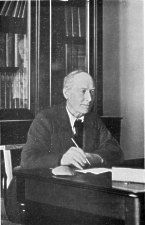
Philip Moore Callow Kermode, M.A.
Curator of the Manx Museum 1922-1932
Born at Ramsey 24th March, 1855. Died 5th September, 1932
[From 5th Report - 1918]

Philip Moore Callow Kermode, M.A.
Curator of the Manx Museum 1922-1932
Born at Ramsey 24th March, 1855. Died 5th September, 1932
At a meeting of the Isle of Man Natural History and Antiquarian Society held at Crosby in Kirk Marown on 16th April, 1908, the Lieutenant- Governor, Lord Raglan, presiding, it was decided to undertake, for the first time, an ArchŠological Survey of the Island: and for this new venture a Committee of members of the Society was appointed with the addition of
(1) The Manx Museum and Ancient Monuments Trustees.
(2) Subscribers of not less than 10/6 per annum.
(3) The Captains of the Parishes, and a representative of each Parish.
It was agreed to observe the following order in carrying out the work
(1) Keeills or Chapels, and Rhullicks or Christian Burial Grounds
(2) Circles, Cairns, Barrows or pre-Christian Burials;
(3) Camps, Forts, Earthworks, and pre-historic Settlements,
and to begin with the Keeills in Kirk Marown, the central Parish, commencing with St. Trinian's.
The Survey was something entirely new, and one which has not been undertaken so far in any other part of the British Isles. It was a well-planned and comprehensive scheme to obtain light on the early ecclesiastical history of the Island.
Mr. Kermode, who had conceived it, was practically single-handed in carrying it into effect, and one cannot but wonder at the devotion, industry and skill with which he achieved so much without anything approaching adequate assistance in the way of skilled labour or financial support. The total amount expended from 1908 to 1918 was only £135.
Reports were presented to the Committee on 7th May, 1909, 23rd September, 1910, 26th October, 1911, 19th November, 1914, and 27th March, 1918.
The first four were duly printed and published, but the fifth, the present one, was unavoidably held over.
In the course of his investigation of the Keeills, Mr. Kermode arrived at the conclusion that many of them occupy the sites of the earliest Christian places of worship, and that it is possible that they are the actual remains of those primitive oratories. The discovery within their precincts of crosses as early as of the fifth century appears to lend support to his opinion.
The manner of construction of some of the more ancient ones, with walls of stone unnecessarily massive for such comparatively small enclosures, suggests that they were erected when buildings of stone were in their infancy.
Mr. Kermode also discovered that several of the Keeills had been built upon burial sites of the Bronze Age, many pagan practices having persisted into Christian times.
The Survey has brought to light a large number of sepulchral monuments which are now carefully preserved in the several parishes and protected from damage through neglect or by wilful injury. Casts of them are housed in the Manx Museum, as well as Mr. Kermode's realistic, full-sized and detailed drawings of over 140 Celtic and Scandinavian monuments, arranged in chronological order in the new Kermode Gallery of the Museum of which he was the virtual creator.
In order to complete his scheme, and to do justice to his memory, it is much to be desired that the survey of the retraining Sheading of Rushen, which comprises the Parishes of Kirk Malew, Kirk Arbory, and Kirk Christ Rushen, should now be undertaken and completed as early as possible.
He has added a new chapter of surpassing interest to our knowledge of earliest historic and pre-historic times in the Isle of Man.
J.K.
|
|
||
| |
||
|
|
||
|
Any comments, errors or omissions gratefully received
The Editor HTML Transcription © F.Coakley , 2011 |
||